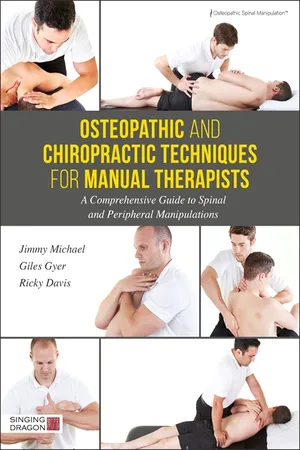![]()
PART I
Theory
![]()
CHAPTER 1
Manipulation
Therapy Theory
Introduction
Manipulation therapy is a type of physical therapy that is practised worldwide by health care professionals in various specialities, such as osteopathy, chiropractic and physiotherapy, to treat musculoskeletal pain and disability (Rubinstein et al., 2011). The therapy uses drug-free, non-surgical techniques to reduce joint pressure, improve joint range of motion, restore muscle and tissue balance, promote body fluid mobilisation, decrease inflammation and enhance nerve function (Di Fabio, 1992; Cyriax, 1973). Scientific research on this modality continues; so far, a number of positive clinical findings have been reported. However, the theoretical base to support every aspect of its therapeutic use is still underdeveloped (Evans, 2010). Hence, the therapy has primarily been used for the management of a range of muscle and joint conditions.
Although the volume of research on joint manipulation has increased significantly in recent years (Bronfort et al., 2008), little is understood about how this therapy works and what physiological effects it causes on various parts of the body (Evans, 2002). To date, many theories have been proposed to interpret these physiological mechanisms, but a unified theory based on scientific evidence is still lacking. However, this chapter is not written to offer a new theory based on the previous literature. Its purpose is to review features suggested to be essential components of manipulation and discuss various theories on physiological mechanisms that have been proposed up to now.
History
Historically, manipulation is one of the oldest techniques, which has its origins in parallel developments throughout the world (Schiötz and Cyriax, 1975). For thousands of years, it has been widely practised in many cultures to treat a variety of conditions associated with the musculoskeletal and other systems. The techniques have been carried down from one generation to the next (Wiese and Callender, 2005). The earliest record of the practice of spinal manipulation is found in China, which dates back to 2700 bce (Waddell, 1996). In Europe, Hippocrates (460–385 bce) was the first physician to describe the manipulation techniques (Withington, 1948).
Despite having an early history of parallel developments in many parts of the world, manipulation therapy has gained and lost favour with the medical profession many times over the centuries (Pettman, 2007). During the renaissance of medicine in the 16th century, Hippocrates’ manipulation techniques reappeared in the writings of a number of famous scholars, including Guido Guidi, Johannes Scultetus and Ambrose Paré, as a treatment for musculoskeletal conditions (Anderson, 1983; Pettman, 2007). Nevertheless, by the 18th century, the general acceptance of these techniques was rejected by physicians and surgeons. They viewed manipulation therapy as a practice of folk healers, also known as bonesetters, and attributed its successes more to luck than skill (Lomax, 1975).
From the 19th century onwards, the therapy became an area of dispute among medical professionals. However, because of shortcomings in allopathic medicine and the origination of two leading alternative health care systems, osteopathy and chiropractic, by the end of the 19th century, views about manipulation therapy irrevocably changed (Anderson, 1981); in the early part of the 20th century, medical and osteopathic physicians initially paved the way for introducing manipulation techniques to the physical therapy profession. Since then physical therapists have contributed substantially to the field and solidified manipulation therapy within in its legally regulated scope of practice (Pettman, 2007).
What is Manipulation?
There is no satisfactory definition of manipulation because of its colloquial function. The term is so vague that many authors have found it very challenging to distinguish ‘real’ manipulation from its physical therapy counterparts (e.g. Song et al., 2006; Colloca, Keller and Gunzburg, 2004; Harvey et al., 2003). Many researchers have tried to provide a valid definition in diverse sources of literature, but a final definition has not yet been agreed. Moreover, the definition varies across specialities (Maigne and Vautravers, 2003). For example, in osteopathy, manipulation is not regarded as a complete treatment; rather, it is considered a part of the manipulative treatment strategy for a given patient (Wieting and Cugalj, 2008).
In addition, manipulation therapy is different from mobilisation, because, theoretically, it does not allow the recipient to stop joint movement during the procedure, whereas mobilisation techniques involve application of non-thrust passive motion to the spine that can be prevented by the recipient (Corrigan and Maitland, 1983).
In comparing previous definitions and descriptions of manipulation, Evans and Lucas (2010) presented several empirically derived features that are necessary to define ‘manipulation’ (see box below). The authors divided these features into two categories: the ‘action’ (that which one person, the practitioner, performs upon another, the patient) and the ‘mechanical effect’ (that which occurs within the patient, as a result of the action).
Proposed Empirically Derived Essential Features of Manipulation
Action (that which the practitioner does to the recipient)
•A force is applied to the recipient.
•The line of action of this force is perpendicular (at an angle of nearly 90°) to the articular surface of the affected joint.
Mechanical response (that which occurs within the recipient)
•The applied force creates motion at a joint.
•This joint motion includes articular surface separation.
•Cavitation occurs within the affected joint.
Source: Evans and Lucas (2010)
Types of Manipulation
Although there are many disputes about the definition of manipulation, it generally involves a thrust being applied to the recipient through either a long or a short lever-arm (Di Fabio, 1999). Osteopaths developed the long-lever techniques, whereas chiropractors the short-lever techniques (Maigne and Vautravers, 2003).
In long-lever manipulation (or low-velocity high-amplitude manipulation), the thrust is delivered in a non-specific manner, not directly to the vertebra – for example, to the shoulder, pelvic region or scapular (Shekelle et al., 1992). During this type of manipulation, the practitioner passively moves many vertebral joints simultaneously within their range of motion (Di Fabio, 1999).
On the other hand, the short-lever manipulation (or h...
